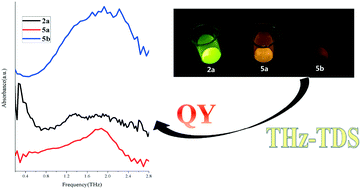New discovery in crystallography: correlation of terahertz time-domain spectra with crystal structures and photoluminescence properties of mononuclear/binuclear diimine–Cu(i)-phosphine complexes†
Abstract
In this paper, a series of mononuclear/binuclear Cu(I) complexes, [CuI(dpq)(PPh3)2](CF3SO3)·CH3OH (1a), [CuI(dppz)(PPh3)2](CF3SO3)·CH3OH (1b), [CuI2(dpq)2(dppm)2](CF3SO3)2 (2a), [CuI2(dppz)2(dppm)2](CF3SO3)2 (2b), [CuI(dpq)(dppp)](CF3SO3)·CH3OH (3a), [CuI(dppz)(dppp)](CF3SO3)·CH3OH (3b), [CuI(dpq)(POP)](CF3SO3)·CH3OH (4a), [CuI(dppz)(POP)](CF3SO3)·CH3OH (4b), [CuI(dpq)(xantphos)](CF3SO3) (5a), and [CuI(dppz)(xantphos)](CF3SO3) (5b) {dppm = 1,1-bis(diphenylphosphino)methane; dppp = 1,3-bis(diphenylphosphino)propane; POP = bis[2-(diphenylphosphino)phenyl]ether; xantphos = 4,5-bis(diphenylphosphino)-9,9-dimethylxanthene; dpq = pyrazino[2,3-f][1,10]-phenanthroline; dppz = dipyrido[3,2-a: 2′,3′-c]phenazine} have been synthesized and characterized by using IR, NMR, elemental analysis, terahertz (THz) time-domain absorption spectroscopy, UV-vis and fluorescence spectroscopy methods as well as single crystal X-ray diffraction analysis. The single crystal X-ray diffraction results indicated that the immediate geometry around each central Cu(I) in the above complexes is a distorted tetrahedron with the central metal atom being coordinated by the two phosphorus atoms of the phosphine ligands and two nitrogen atoms of the bidentate N-containing heterocyclic ligand moieties. It is found that complexes 1a–5a and 5b show photoluminescence in the solid state at room temperature with the highest quantum yield up to 0.5519, and the increased conjugation in the diimine ligands leads to emission reduction along with a red-shift in the emission maxima. Detailed photo-physical studies and density functional theory calculations (DFT) of these complexes have revealed that their lowest energy absorptions and emissions are ascribed to metal-to-ligand charge transfer (MLCT) excited states. The above results indicate that conjugation effects of N-heteroaromatic ligands play a significant role in the emission properties of mononuclear/binuclear Cu(I) complexes. For the first time, terahertz time-domain spectroscopy is applied for qualitatively understanding the photophysical properties of complexes, revealing that terahertz time-domain spectra are sensitive to the weak interaction between the ligands, especially the diimine ligands, and terahertz spectra are strongly correlated with photoluminescence quantum yields of the complexes.



 Please wait while we load your content...
Please wait while we load your content...